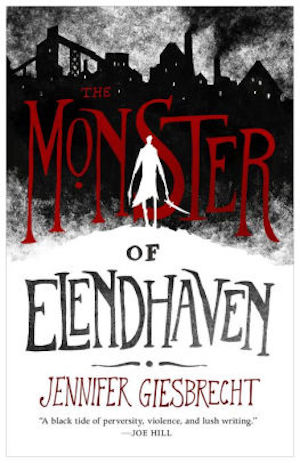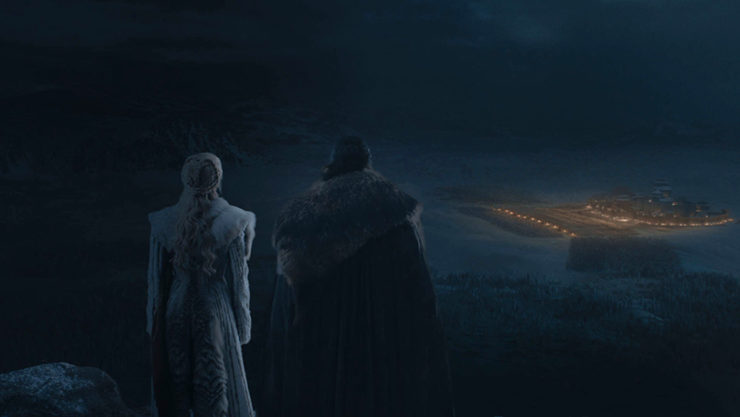Aside from being great TV, Game of Thrones has been a wonderful way to bring academic expertise and public engagement together, and this most recent episode was no exception. So let’s talk about “The Long Night” and history. Put on your helmets, folks. (Should be plenty around, since most of the cast doesn’t use them…)
Warning: Spoilers to follow.
Also, let me preempt a whole line of comments by noting that, yes, I know this is fantasy. Real history doesn’t have dragons and undead and spells and all that jazz.
But you know what? Having all that fantasy stuff actually makes the real-world oddities of the Battle of Winterfell all the more glaring.
Again, spoilers to follow.
Seriously.
Let’s start with The Plan.
First, I love that we got a planning scene in the previous episode. As it was with the Battle of the Bastards, it’s good to have a basic sense of what everyone is trying to do.
The plan didn’t work for Battle of the Bastards, of course. As I’ve talked about before, Jon Snow made a Leeroy Jenkins out of it. Honestly, for all that I love Jon, he’s a terrible field commander. More on that in a bit.
Anyway, at Winterfell they have a Plan, too. And I know some folks were complaining that it wasn’t too detailed, but honestly it felt pretty right. By comparison, the current issue of Medieval Warfare Magazine has a lot of discussion of the Battle of Agincourt in 1415, including my translation of the French battle plan. Here’s a sample of the oh-so-detailed scheme from one side of one of the most famed engagements in history: “all the archers of the whole company will stand before the two wings of foot-soldiers, where they will be commanded by the knights and squires appointed by the leaders of each wing, each on his own side.” Yeah, that’s it. (Most scholars think this battle plan is associated with the campaign but never put into action; in an accompanying article, my colleague Kelly DeVries suggests it was for Agincourt itself, and I quite agree—but this only makes sense if the battle is slightly relocated, which I argue for in that same issue.) In other words, The Plan at Winterfell, to me, felt right in terms of its depth and its existence in the first place.
But it was a terrible plan.
Look, here are the facts as they had them:
- Big-ass army of undead on the way
- Said army has a dragon
- Its defeated members come back to life at the whim of its leader, the Night King
- He can do the same for your defeated members, too
Got that? For each death in the field, the Night King gains one and you lose one.
What’s Step 1 in your plan?
Why, to send a cavalry corps into them! Oh, and that cavalry, by the way, is armed with plain ol’ useless weapons until Her Slowness, Melisandre, mosies out of the gloom completely unexpectedly.
Even with that help, Step 1 boils down to “Here’s a Dothraki Horde, m’ lord of Night. May this gift ever worsen our plight.”
Meanwhile, you stuff all the helpless folks in a crypt as if no one could see where that was going. Tyrion is waxing on about how he could be useful if he could be out there and think of something and I’m like “You’re leaning on a sarcophagus!” Come on, y’all. I’m #TeamTyrion over here!
Step 2 is to hand over the Unsullied and the Night’s Watch along with the rest of your most able fighters. Because obviously. (Also, I’m trying really hard not to read anything into how casually the eastern Dothraki and Unsullied are tossed aside to save the people of Westeros.)
A corollary to Steps 1 and 2, of course, is that you very definitely should not engage the enemy with your badass dragons until you really need to do so. I mean, why waste the opportunity to uselessly hand over the vast majority of your fighting force to the enemy?
Sweet baby Aegon, I hate plot-by-stupidity.
Here’s the thing, folks: Use your walls. That’s why you built the damn things. (Hey, remember how silly it was to leave Dragonstone wide open?) Sit back and do dragon runs across the front of the walls until the Night King shows up!
For crying out loud, during this oh-so-intense-and-serious episode I actually laughed when, after the inevitable disastrous retreat into the walls that they should have been inside already, everyone starts shouting to man the walls. For realsies? Y’all didn’t think about that as, say, Step 0?!?
No, no. Step 0 was to put Three Raven Nut Bran into the Godswood with Twelve Dudes and Theon as protection.
Buy the Book


The Monster of Elendhaven
Why so few? Because everyone knows Bran is the Night King’s ultimate target. Thus, because the Godswood is largely exterior to the great walls of Winterfell and less protected, we can definitely count on the Night King to not, like, attack it directly by landing on it with his gorram dragon. Likewise, we can be sure that he won’t even attack it indirectly via a flanking maneuver with his vastly superior numbers of white walkers who could’ve easily clambered inside it and killed everyone within about five minutes. Instead, the Night King, we can be sure, will try to get to Bran and the Godswood via the most difficult entry possible.
Which, to be fair, is exactly what the Night King does. Being undead gives you snow for brains. ::rimshot::
And I swear to R’hllor, when I say everybody needs to have helmets I mean you, too, Arya. Almost got caught by white walkers on account of the blood dripping from your head wound? You’ll never guess what might have prevented that sort of head wound!
So yeah, The Plan is a damn terrible one against any tracking of historical warfare.
But…how was it as a TV episode?
Pretty damn incredible.
Not quite Battle of the Bastards good for me, though part of that is definitely because it was so friggin’ hard to track things in the gloom. I get that the whole thing needed to be at night given that it was the Night King and the fire stuff looks way cooler at night, but I sure would have appreciated more framing to track the action. The dragon business should have been amazing—dragons fighting! Huzzah!—but it was instead mostly annoying. Which dragon just got bit? Who is being attacked now? Did a dragon just die? What’s the air-lift capacity of a dragon given that its wing-to-body ratios got me raising an eyebrow that it can even get itself off the ground?
Yet there were amazing moments. The episode reportedly took 55 straight night shoots, and I can see that. Though the final strike was made by Arya—Hell yeah for that full circle, by the way—the final sequence of Jon’s charge into Winterfell is what is stuck in my mind. It was absolutely extraordinary. I’ve had some limited exposure to being on a film set and trying to track through action with multiple cameras, and I can’t imagine the organization and expertise they needed to choreograph that stretch. Add in the emotional beats as Jon saw everyone going down, his unwillingness to stop even in the face of Sam wounded and screaming…it was just brilliant.
Then—then!—they followed it up with that run down a collapsing corridor that was a long one-shot with stunt people and debris flying and a 180-degree camera turn in the middle. I’m gonna be rewatching that quite a few times, just to see superb filmmaking at work.
Something else the episode did well—I mean really well—is to show the human will to survive against all odds. Desperation in battle brings either despair or determination. I would have liked to see some more of the former outside of Sam—because, frankly, too few of us, in the end, are truly heroes—but I still loved seeing so much of the latter.
My friend Kelly (mentioned above) texted me afterwards, likening the episode to what it must have been like to be the last man at Custer’s Last Stand or at Thermopylae. He’s exactly right. And yes, he and I both know that the truth about Custer and the 300 (don’t get me started) is nothing like the racially driven propaganda that’s been built around them. But to talk about the lived last moments of those men we must set aside the myths about why their last stands were taken. The last men at the Big Horn or the Hot Gates were unlikely to be thinking of the politics that would surround their deaths. If they didn’t succumb to the despair, folding up and waiting to die, then they were fighting on with ever-increasing determination. They wanted, above all else, to survive. As Bryhtwold supposedly said at the Battle of Maldon in 991, as his lord fell in battle against the Vikings—another last stand turned myth—“Will must be the harder, heart the bolder, / our spirit the greater, while our strength fails.”
Or here’s one of the men from the Fight at Finnesburh just a few years later:
But now battle begins: the startled birds mourn,
The wan-wolves howl, the war-wood resounds,
The shield answers shaft. Now shines the moon
Wandering under clouds. Now woe-deeds come,
Which these people’s hate makes happen.
Awaken yourself, my warriors now,
Heft your linden shields. Take courage to heart,
Fight in the front, be fierce in spirit!
This fighting spirit when facing down certain death—the men at Finnesburh were trapped and surrounded in a hall, doomed to die—is one of the many reasons I study battle so intently. It’s not the glory of warfare that fascinates me. I don’t even know what that is, except to know that it exists in the fevered dreams of cultists. Nevertheless, sometimes our most desperate moments provide our clearest glimpses of who we are. In Game of Thrones that’s true whether it’s Brienne, backed against an old stone wall, giving her every last ounce of strength toward the cause of knighthood that she‘s always upheld, or Sansa and Tyrion sharing a tender moment amid the unspeakable horror.
The Battle of Winterfell captured this last stand spirit. For that I am grateful. The fact that more Headline Folks didn’t fall against that certain death is perhaps a bit underwhelming given the gravity of the odds they faced—though obviously RIP Theon, Jorah, and above all Lady Mormont—but perhaps this just means a far greater, far more desperate last battle is yet to come.
So bring it on, Game of Thrones.
I’ll bring the popcorn…and a helmet.
PS: the source for all the medieval material quoted here, and much other primary material besides, is the forthcoming Medieval Warfare: A Reader, edited by myself and Kelly DeVries (University of Toronto Press).
 Michael Livingston is a Professor of Medieval Culture at The Citadel who has written extensively both on medieval history and on modern medievalism. His historical fantasy trilogy set in Ancient Rome, The Shards of Heaven, The Gates of Hell, and The Realms of God, is available from Tor Books. His new fantasy novella “Black Crow, White Snow” will be released on Friday, May 3rd as an Audible Original.
Michael Livingston is a Professor of Medieval Culture at The Citadel who has written extensively both on medieval history and on modern medievalism. His historical fantasy trilogy set in Ancient Rome, The Shards of Heaven, The Gates of Hell, and The Realms of God, is available from Tor Books. His new fantasy novella “Black Crow, White Snow” will be released on Friday, May 3rd as an Audible Original.










